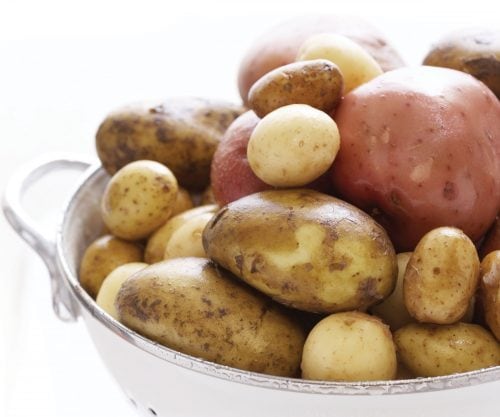
Potatoes are inexpensive, readily available and one of the most popular vegetables in New Zealand and Australia.
Their popularity makes these versatile vegetables an important contributor to our nutrition — potatoes provide 12 per cent of our dietary fibre, eight per cent of our carbohydrate intake and are also a source of vitamin C, potassium, folate and niacin.
Varieties and uses
There are over 50 varieties of potatoes grown all over the country and can be harvested year-round. However, only 10 to 12 varieties are readily available at any one time.
- Waxy and smooth textured. These types are best for boiling, salads, stews and casseroles. They have a high water content and are low in starch, so they hold their shape during cooking.
- Floury or fluffy potatoes have a lower water content and are higher in starch. They tend to break easily when cooked, so they’re good for mashing, chips and wedges, baking and roasting.
- Some potatoes are in between waxy and floury. These are good all-round potatoes that can be used for most cooking methods.
- Note: Some varieties can change naturally during the season: they may start off as waxy and over time become more floury. Potatoes are also affected by the weather, time of year and growing conditions.
Nutrition
Potatoes are a high-carbohydrate vegetable with most of that being made up of starch. They provide fibre, vitamin C, B vitamins and are an excellent source of potassium. An average cooked potato (140g) with the skin on provides approximately 490kJ, 23g carbs and 3g fibre. Most of the fibre and minerals are just under the skin so if possible, keep the skin on when cooking and eating. Retaining the skin also helps maintain vitamin levels during cooking.
Glycaemic Index
The Glycaemic Index (GI) ranks carbohydrate foods based on how they affect blood sugar levels. The faster the blood sugar response after eating a carbohydrate food, the higher its GI ranking. Potatoes have a high GI ranking of 65-101 depending on the variety of potato and cooking method. Mashed potatoes, or those that are peeled, tend to be higher than those that are more waxy and boiled. Cold, boiled potatoes have a lower GI as the starch forms resistant starch — a type of fibre we need more of — which lowers the GI ranking.
Not all foods need to be low-GI at every meal but reducing the overall glycaemic load of our diet is a good idea. Remember, the overall GI of a meal is lowered when potatoes are combined with protein and fibre-rich foods.
Storage
Potatoes keep best in a cool dark place, not in the fridge where the flavour may change. Storage in plastic bags is not ideal, so try using a cardboard box. Potatoes also need gentle handling — they may look tough but they can bruise easily.
When potatoes are exposed to light they can develop a green colour from chlorophyll forming in the surface layers. This is associated with the formation of a toxin called solanine, which means green potatoes should not be eaten.
How to choose
Choose potatoes that are free from cuts, bruises, green patches and sprouts. Select the variety suited for the cooking method you are after.
Tip: Remember when cooking or eating potatoes to limit salt and use only small amounts of olive oil or reduced-fat spread, instead of butter, to limit saturated fat.
Article sources and references
- A S Wilcox www.aswilcox.co.nz Accessed March 2015https://www.wilcoxgoodness.co.nz/
- Alliance for Potato Research and Education. 2012. The white potato. An affordable, nutrientdense vegetable. www.potatoes.co.nzhttps://potatoesnz.co.nz/
- Food and Agriculture Organisation of the United Nations. 1990. Roots, tubers, plantains and bananas in human nutrition. Chapter 6. Effect of processing on nutritional value. www.fao.org/docrep/t0207e/t0207e07.htmhttp://www.fao.org/3/t0207e/t0207e07.htm
- Lister CE et al. 2000. Nutrition and health qualities of potatoes — a future focus. Crop & Food Research Confidential Report No.143 www.vegetables.co.nzhttps://www.vegetables.co.nz/
- Lister CE October 2013. The composition and health benefits of potatoes — an update (2009-2013). Plant & Food Research:Lincoln Ministry of Health. 2006. Nutrient reference values for Australia and New Zealand: including recommended dietary intakes. Canberra: Commonwealth of Australiahttps://www.plantandfood.co.nz/
- Sivakumaran S. et al 2013. The concise New Zealand food composition tables 10th ed. Wellington: New Zealand Institute for Plant & Food Research Ltd and New Zealand. Ministry of Healthhttp://www.moh.govt.nz/notebook/nbbooks.nsf/0/2fa2c987c25e81fecc25762c0075a805/$FILE/Concise_8_Edition.pdf
- www.potatoes.co.nz Accessed March 2015https://potatoesnz.co.nz/
www.healthyfood.com










